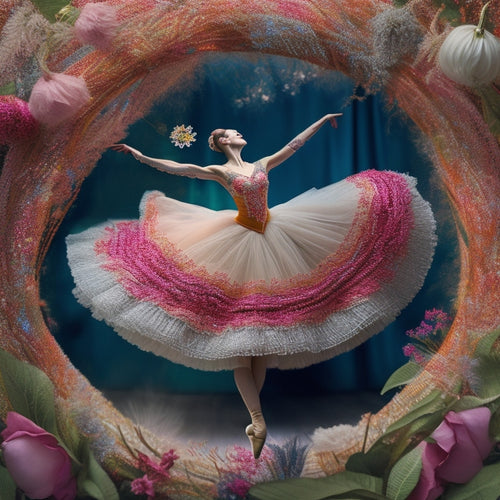
Improving Dance Accessibility: Embracing Differences
Share
Improving dance accessibility is essential for creating an inclusive environment where dancers of all abilities, backgrounds, and experiences can thrive. By acknowledging and valuing diverse experiences and abilities, we can promote independence, empowerment, and celebrate individuality. This begins with prioritizing physical accessibility in dance spaces, offering tailored classes and workshops, and recognizing the unique strengths and challenges of each dancer. Embracing differences in dance fosters a vibrant community that promotes equality and celebrates diversity. As we continue to create inclusive spaces, we uncover the full creative potential of dancers, leading to a richer, more diverse, and vibrant dance community.
Key Takeaways
• Embracing differences in dance fosters a vibrant community that promotes equality and celebrates individuality.
• Inclusive dance spaces support dancers of diverse backgrounds and abilities, providing physical accessibility and tailored classes.
• Recognizing unique strengths and challenges of each dancer is essential for creating an environment that values diversity.
• Providing accommodations like sign language interpretation and implementing a zero-tolerance policy against discrimination is crucial for inclusivity.
• Enhancing accessibility in dance spaces empowers individuals, promotes independence, and increases participation in the dance sector.
Enhancing Accessibility in Dance
Enhancing accessibility in dance spaces is an essential step towards creating an inclusive environment that fosters independence and autonomy for all users, regardless of their abilities. By increasing awareness of access barriers, we can promote independence and empower individuals to fully engage with dance activities.
This is particularly vital for individuals with disabilities, who often face significant obstacles in accessing dance spaces. By addressing these barriers, we can create a more inclusive and welcoming environment that values diversity and promotes equality.
Through this project, we aim to provide practical guidance and resources to support dance venues in enhancing accessibility, ultimately increasing participation and promoting a culture of inclusivity in the dance sector.
Embracing Differences in Dance
By acknowledging and valuing the diverse experiences and abilities of dancers, we can create a more inclusive and vibrant dance community that celebrates individuality and promotes equality. Embracing differences in dance means recognizing the unique strengths and challenges of each dancer, regardless of their abilities or backgrounds.
By doing so, we foster an environment that celebrates diversity and promotes inclusion. This inclusive approach not only enriches the dance community but also allows dancers to feel seen, heard, and valued.
Creating Inclusive Dance Spaces
Regularly, dance spaces that prioritize inclusivity become hubs for creative expression, social connection, and personal growth, fostering an environment where dancers of diverse backgrounds and abilities can thrive.
Creating inclusive dance spaces is vital in promoting diversity and supporting inclusion.
To achieve this, consider the following strategies:
-
Ensure physical accessibility by providing ramps, elevators, and adaptable restrooms.
-
Offer classes and workshops tailored to diverse abilities and needs.
-
Foster a culture of respect and empathy among instructors and dancers.
-
Provide accommodations such as sign language interpretation or audio descriptions.
-
Develop a zero-tolerance policy for discrimination and harassment.
Frequently Asked Questions
What Is the Ideal Ratio of Accessible to Non-Accessible Dance Spaces?
Ideally, a 1:1 ratio of accessible to non-accessible dance spaces is ideal, ensuring inclusive design and space allocation that caters to diverse needs, fostering freedom and autonomy for all users.
Can Existing Dance Venues Be Retrofitted for Accessibility?
Retrofitting existing dance venues for accessibility is an important step towards inclusivity, but it's no easy feat, requiring careful consideration of retrofitting challenges, cost estimates, space reconfiguration, and thorough accessibility audits to guarantee a truly liberated dance floor for all.
How Do I Create an Accessibility-Focused Dance Class for Beginners?
To create an accessibility-focused dance class for beginners, utilize inclusive language, adaptive routines, and gentle guidance to foster safe spaces, promoting autonomy and empowerment for all participants, regardless of abilities.
Are There Any Grants Available for Dance Venues to Improve Accessibility?
Dance venues seeking to enhance accessibility can explore funding opportunities, such as government grants or foundation awards, to support accessibility audits and modifications, ensuring inclusive spaces for all patrons.
Can Dance Instructors Receive Accessibility Training and Certification?
While dance instructors often possess a deep understanding of movement, they may lack the expertise to create inclusive environments; instructor empowerment through accessibility training and certification can bridge this gap, overcoming training barriers and fostering a culture of inclusivity.
Related Posts
-

Benefits of Wearing Activity Trackers Daily
Wearing an activity tracker daily can transform your fitness routine. You'll gain understanding into your daily steps...
-

Dance Into Creativity With Ballerina Embroidery Pattern
Ignite your creative potential with the enchanting ballerina embroidery pattern, where artistry meets precision. This...
-

Issuu's Dynamic Flipbook Creation: Engage & Share
Issuu's dynamic flipbook creation platform revolutionizes digital content creation, offering an intuitive and seamles...


